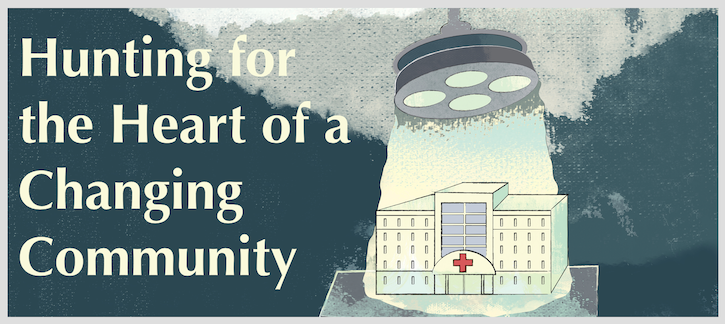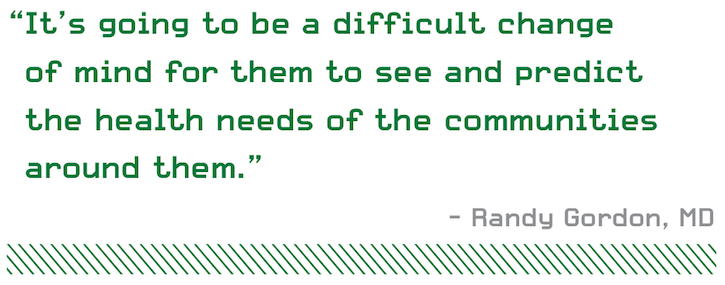Hunting for the Heart of a Changing Community
Neighborhoods nationwide are facing new shocks ranging from spiking suicide rates to surging populations. Health systems can manage these swings with high-tech tools.
This is the cover story from our April 2018 issue. Our bimonthly print magazines are available for free at this link.

IT WAS A DREADFUL MONTH in what was shaping up to be an even worse school year. Upon its arrival, February 2014 began pummeling the people of Douglas County, Colorado, leaving a special bruise on its 68,000-student school system. Four teenagers killed themselves in the first 11 days of the month. All but one were enrolled in the district. Their suicides rendered their parents heartbroken, their peers confused, and local officials struggling to comprehend the scope of the problem at hand.
“It is our understanding that there is no link other than geographic proximity between these 4 tragic deaths,” the district’s superintendent wrote in a letter to parents. “However, as a community, we need to be aware that anytime there are multiple deaths in a short time period, there is an increased risk for imitation.” Months earlier, a family buried an eighth-grade girl who reportedly had joined a suicide pact with several friends. In 2009, a popular high school boy took his own life. A year before, 3 teens killed themselves in the span of 24 hours. Tragic as each individual event was, together they contributed to rising suicide rates, both in the county and Colorado at large, which had stirred legislators and community leaders to search for solutions.
Not long before, Centura Health opened a 50-bed, $128 million hospital in the county seat, Castle Rock. The faith-based health system was rapidly expanding, and it saw in the community an entity going through a similar transition. Seated halfway between Denver and Colorado Springs, Castle Rock had swollen from roughly 8600 to 56,000 residents since 1990, reflecting a countywide blossoming. The new, upper-middle-class, highly-educated population needed somewhere to go when they got sick.
So when 5 teenage girls tried to commit suicide during that dark period, they ended up in Castle Rock Adventist Health. “We lost a couple,” says James Corbett, JD, Centura’s senior vice president and chief mission officer, “and I can tell you that changes the community and changes the way you work in that community.”
Health Tech’s Mirror on the Wall
They might seem worlds apart, but public health issues, such as suicide, and demographic trends, like population growth, present healthcare organizations with challenges and opportunities that share common blood. Each phenomenon generates diverse data, and each data point melds to form a clearer picture of what, exactly, is going on in a community. If a health system so desires, it may corral disparate pieces of information to more effectively anticipate and meet the needs of the fluctuating populace it serves, according to experts interviewed by Healthcare Analytics News™.
What makes this sort of population health campaign possible are new tools—electronic medical records, big data, artificial intelligence (AI)—and creative information gathering. Such efforts can yield insights that optimize care and increase value. They hold the power to enable health systems to navigate, say, gentrification or urban decline and societal crises, from suicide to diabetes to opioid abuse.
In Camden, New Jersey, healthcare visionaries have used data and analytics to hot-spot public health on a block-by-block basis, permitting them to tackle housing issues associated with excessive emergency department readmissions. In Maine, a health system examined population data to identify locations for behavioral health clinics to combat the opioid crisis, a notable feat for a state where wilderness reigns. In Mississippi, the difference between a few percentile points has helped healthcare draft targeted interventions for diabetes.
The timing for population health is right. Over the past decade, major metro areas have been swelling, especially places such as New York, San Francisco, Nashville, Austin, and Denver. Conversely, low-income individuals who once occupied city neighborhoods are migrating to suburbs and the countryside, says Steven Pedigo, MS, MA, who heads an urban lab at New York University and directs the advisory firm Creative Class Group. Millennials, empty nesters, the working poor—they’re all on the move, and they’re moving all over.
But healthcare is only beginning to take a high-tech approach to analyze communities, experts say. The cutting-edge practice, after all, stands to topple long-held approaches and business motivations, causing some hesitance, they say. Novelty makes existing examples and lessons all the more valuable. “If healthcare has a burden or a role to play in meeting unmet needs, then big data has to be part of the solution,” says Michael Topchik, MA, national leader for the Chartis Center for Rural Health, a firm that uses data to develop and improve health networks outside the urban core and suburban rings.

How Data Pinpoint Health Needs
Castle Rock Adventist Health is but one of Centura Health’s 17 hospitals, which constitute just one arm of a network that encompasses dozens of clinics and more than 100 physician practices in Colorado and western Kansas. The nonprofit health system’s facilities serve cities, such as Denver and Pueblo, along with isolated mountain towns and suburbs, a footprint that has made it important to scrutinize the demographic, public health, and social data of each place. “It’s essential to understand our communities and how they’re changing, becoming more diverse and culturally different, and then address it on that level,” says Corbett, the Centura executive.
The people who patronize Centura’s hospital in Garden City, Kansas, for example, kill 30,000 cattle per day, putting them in the crosshairs of different health issues from those of the urban patients who walk into Denver’s Porter Adventist Health. In fact, Corbett adds, the network is seeing more amputations among young adults, who are settling in the Mile-High City without health insurance and then breaking bones while skiing. In Pueblo, Colorado, more than elsewhere, Centura clinicians are battling the effects of the opioid crisis. Canyon City, on the other hand, is struggling with violent crime, and 18,500-resident Durango has its own suicide problem.
So what is Centura Health doing to collect and interpret the right data to tell the story of each population?
First, every 3 years, it performs a needs assessment for which staffers compile quantitative data from public health departments, health data exchanges, and insurance claims—along with qualitative interviews of various players in each neighborhood—to get a feel for factors like tobacco use, alcohol consumption, and violent crime, Corbett says. Centura also scours its emergency department data to glean insights that could predict coming trends. Further, the health system undertakes healthcare market analyses across Colorado, a process that homes in on demographics.
The health system obtains hard numbers from public health departments, sometimes paying for the privilege. It also participates in the Colorado Regional Health Information Organization, a health information technology exchange that curates and promotes the flow of de-identified patient data among the state’s hospitals. Then there are claims databases, another pay-to-access data well for Centura. Next, employees sit down with community stakeholders—churches, police departments, fire departments—to tap their on-the-ground knowledge.
Finally, the organization employs analytics and other tech-centric tactics to make sense of everything. “We’re in an era where there’s data overload, and too much can be a problem,” Corbett adds. “What we’re trying to do is take a bunch from different sources and turn it into useful information.”

What’s Changing?
Data collection isn’t new. Neither are healthcare’s efforts to forecast market demand. But aside from advanced analytics and AI, experts say innovative population health efforts differ from data endeavors of the past 50 years in a key way: They don’t revolve around managing the disease state. “Hospitals didn’t treat wellness; they treated sickness,” Topchik, of Chartis, said. “So they used big data to pinpoint every cardiology patient in a geography, understanding who went where, which procedure they received, and how much they paid.”
Subsequently, health systems placed cardiac specialists in areas rife with fast-food restaurants. Health systems also learned how to maximize staffing schedules so that each physician might see X number of patients each day, for Y minutes, to earn Z dollars. Without hesitance, experts acknowledged that this sort of fee-for-service-driven data gathering remained more common than outcomes-driven, long-range planning.
“Health systems have been in the business of competing on a basis of who provides the better service. They don’t necessarily segment the demographics,” notes Randy Gordon, MD, a managing director with Deloitte Consulting. “They have been accustomed to looking at the population on an insurance status—and how they can best serve populations for whom they get paid.” The thing is, how healthcare organizations get paid is shifting with the ascent of value-based care. Only the charge toward wellness and value have led hospitals to embrace population health, and most have yet to tweak their care plans to more heavily consider criteria like demographics. “I think that’s coming,” Gordon says, “but it’s right at the beginning.”
The technology that’s opening the door to community-based planning is the electronic medical record (EMR) system. Over the past several years, EMR adoption rates have soared, thanks in part to billions of dollars in government incentives, to the point where it’s rare for a hospital to run on paper. Despite its interoperability and workflow issues, the EMR has empowered health systems to absorb clinical and demographic data, laying the groundwork for analytics that result in actionable insights, Gordon says. Such an act was all but impossible in the paper age.
Even better, the EMR data trove can extend into outpatient, primary care, and surgical data, sometimes collecting social determinants of health and other demographic elements. “Without having digitized this information, there would really be no way to look at the populations that they serve,” Gordon says.

Kaiser Permanente, which has roots in Castle Rock, Colorado, has been in the population health business for some time. Gordon notes that the health system built out a large EMR database that fostered population-level illness prediction, chronic disease and comorbidity management, and upstream wellness and prevention programs.
Demographic and public health tracking has produced intriguing results for Centura and Castle Rock Adventist Health. For example, the health system analyzed the numbers and found that one-on-one substance abuse and suicide interventions in schools weren’t working, so it began using an AI chat bot. The program altered the conversation, building trust in community members and resulting in better outcomes among 80% of the people who use the chat bot, Corbett says.
By determining community needs, Centura has moved mountains—or, more accurately, buildings. In Westminster, Colorado, the health system opted to relocate a hospital and repurpose the old site to better support the community’s mental health needs by opening a crisis stabilization unit. Colorado has fewer than 5 crisis beds per 100,000 residents, a statistic that Corbett says revealed an important care gap. Other data-based decisions have been less dramatic: educational partnerships designed to improve safety in an area where many people ride horses and hospital-sponsored basketball tournaments in gang strongholds. Centura has established urgent care clinics in rural areas to provide much-needed care, and it has beefed up obstetrics in younger communities, Corbett notes.
In the future, hospitals might provide refuge for only the sickest patients. Still, every step forward stems from the EMR—and the alignment of business incentives with population health.
Predicting Community Health
The question seems simple: With the right data and analytics, can a health system predict a neighborhood shift like gentrification before it becomes obvious to clinicians who walk the streets during their lunch breaks? The answer, however, is nuanced.
“The possibility is there,” Gordon says. “It’s going to be a difficult change of mind for them to see and predict the health needs of the communities around them because they’re really focused on people coming into the door.” More likely, he adds, newcomers to the market will bring on this disruption. Outsiders like Apple, Amazon, and even Uber are entering various stages of the care continuum, with their Silicon Valley style of big spending and ambitious re-thinking. Might they force healthcare’s community evolution?
Health systems, however, have incentives today to understand their communities from a data perspective. As a neighborhood’s population and medical needs transform, so too might competitors’ attitudes, a threat in the age of consolidation. A lack of access to primary care and wellness programs, meanwhile, could cause headaches for health systems. At the same time, community data planning conjures patient privacy and cybersecurity questions.
Perhaps the most attractive opportunity offered by community forecasting is enhanced predictive modeling. Experts say it probably won’t become widespread until after high-tech precision medicine cements itself in healthcare, but the prospect of calculating what comes next is tantalizing.
Imagine traveling to Douglas County, Colorado, in the early 1990s, when its population boom was just beginning, with the algorithms and informatics that healthcare has today. Could a team of clinicians and data scientists have taken the pulse of the community and measured where it was headed? Quite possibly, if health system administrators so wished. Insights gained might not have prevented the wave of suicides and heartbreak that came 20 years later, but they would have afforded healthcare and its community partners the chance to try.
This is the cover story from our April 2018 print magazine. Our bimonthly print issues are available for free at this link.Related Coverage:
The Population Health Problems Facing Urban and Rural America
The Intersection of Politics, Poverty, and Pop Health
Community Is Fundamental to Population Health
Podcast: Match Made in Hospitals — Patient-Matching Technology Can Improve Healthcare
September 21st 2021Clay Ritchey, CEO of Verato, highlights the administrative and financial benefits that patient-matching technology can provide hospitals and health systems, as well as how it can improve the patient experience.
Podcast: Using Digital Solutions to Address Technology Shortfalls with Citius Tech Senior VPs
July 29th 2021In an interview recorded earlier this year, Chief Healthcare Executive Associate Editorial Director Mary Caffrey spoke with 2 leaders of Citius Tech about meeting healthcare challenges with digital solutions.